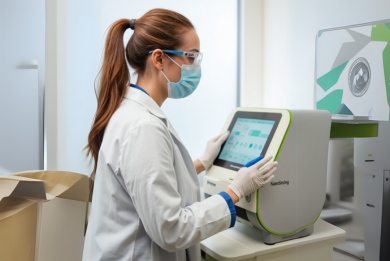NanoString Technology for Cancer Diagnosis in Low-Resource Settings
Cancer diagnosis in low-resource settings faces many challenges, but NanoString technology offers a promising solution. This innovative platform provides a cost-effective and efficient way to analyze gene expression, helping doctors make more accurate diagnoses even in areas with limited resources.
How NanoString Works
NanoString uses a unique method called "molecular barcoding" to count specific molecules in a sample. Here's a simple breakdown of the process:
- Special probes attach to target molecules in the sample.
- These probes have color-coded "barcodes" that identify each target.
- The machine counts these barcodes, giving a precise measure of each target molecule.
This method doesn't need sample amplification, which makes it less prone to errors and contamination. It can also work with lower-quality samples, which is often an issue in low-resource settings.
Benefits for Low-Resource Settings
NanoString technology offers several advantages for cancer diagnosis in areas with limited resources:
- Easy to use: The process is simple and doesn't need much hands-on time. This means staff don't need extensive training to run tests.
- Works with poor-quality samples: In low-resource areas, sample storage and handling can be challenging. NanoString can still get good results from sub-optimal samples.
- Quick results: The technology can provide results in just a few days, which is crucial for timely treatment decisions.
- Cost-effective: While the initial setup cost might be high, the per-test cost is relatively low, especially when running multiple tests at once.
- Versatile: NanoString can test for many different genetic markers at the same time. This is particularly useful for complex diseases like cancer.
- Accurate: Studies have shown that NanoString results match well with other established testing methods.
In a recent study, researchers used NanoString to test for leukemia in Sub-Saharan Africa. They were able to accurately identify different types of leukemia, which is crucial for choosing the right treatment.
NanoString technology is opening new doors for cancer diagnosis in low-resource settings. By providing accurate, efficient, and cost-effective testing, it's helping to bridge the gap in cancer care between high- and low-income countries.
3.Strengthening Immunity in Children: What Frequent Infections Teach Us About Nasal Defense Mechanisms
Kids often catch colds and other bugs more easily than adults. But this might actually be good for them! A new study shows that these frequent infections could help protect children from severe COVID-19.
When kids get sick often, it makes their nose's defense system stronger. This defense system, called innate immunity, is the body's first line of protection against germs. The more germs kids encounter, the better their noses become at fighting them off.
Researchers looked at over 600 nose swabs from children. They found that many kids had viruses or bacteria in their noses, even when they weren't sick. The youngest children, under five years old, had the most germs.
Interestingly, the more germs a child had in their nose, the stronger their nose's defenses were. This might explain why children generally had milder cases of COVID-19 during the pandemic.
Building Strong Immunity in Kids
While frequent infections can help boost immunity, there are other ways to keep kids healthy:
- Healthy eating: Give kids lots of fruits and vegetables. These foods have vitamins and nutrients that help fight off germs.
- Enough sleep: Make sure kids get plenty of rest. Sleep helps the body heal and stay strong.
- Regular exercise: Keep kids active. Exercise helps the body fight infections better.
- Good hygiene: Teach kids to wash their hands often and cover their coughs and sneezes.
- Less stress: Help kids relax and have fun. Too much stress can weaken the immune system.
Remember, it's normal and even helpful for kids to get some infections. These experiences teach their bodies how to fight off germs better in the future.







Comments